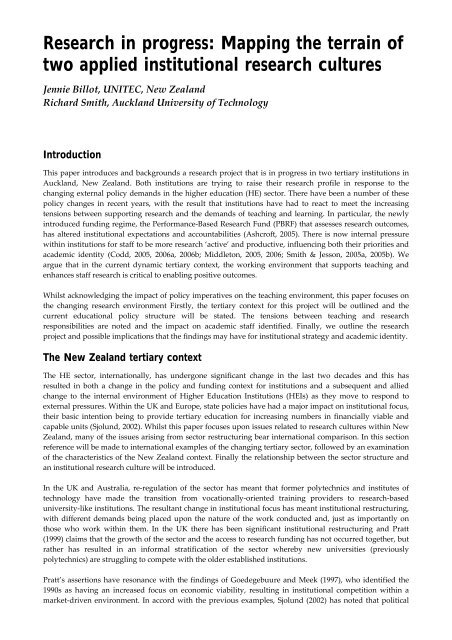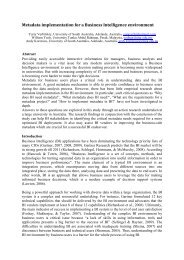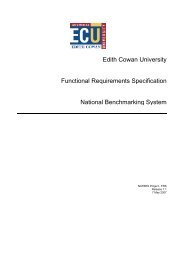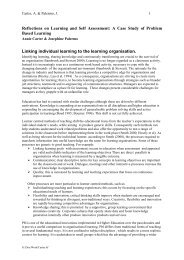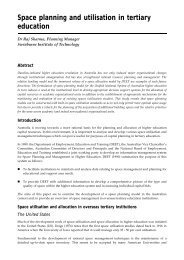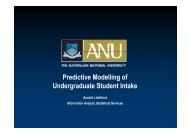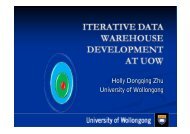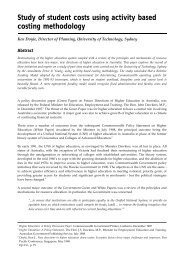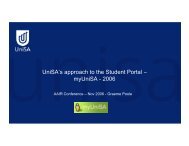Research in progress: Mapping the terrain of two applied ...
Research in progress: Mapping the terrain of two applied ...
Research in progress: Mapping the terrain of two applied ...
Create successful ePaper yourself
Turn your PDF publications into a flip-book with our unique Google optimized e-Paper software.
<strong>Research</strong> <strong>in</strong> <strong>progress</strong>: Mapp<strong>in</strong>g <strong>the</strong> terra<strong>in</strong> <strong>of</strong><br />
<strong>two</strong> <strong>applied</strong> <strong>in</strong>stitutional research cultures<br />
Jennie Billot, UNITEC, New Zealand<br />
Richard Smith, Auckland University <strong>of</strong> Technology<br />
Introduction<br />
This paper <strong>in</strong>troduces and backgrounds a research project that is <strong>in</strong> <strong>progress</strong> <strong>in</strong> <strong>two</strong> tertiary <strong>in</strong>stitutions <strong>in</strong><br />
Auckland, New Zealand. Both <strong>in</strong>stitutions are try<strong>in</strong>g to raise <strong>the</strong>ir research pr<strong>of</strong>ile <strong>in</strong> response to <strong>the</strong><br />
chang<strong>in</strong>g external policy demands <strong>in</strong> <strong>the</strong> higher education (HE) sector. There have been a number <strong>of</strong> <strong>the</strong>se<br />
policy changes <strong>in</strong> recent years, with <strong>the</strong> result that <strong>in</strong>stitutions have had to react to meet <strong>the</strong> <strong>in</strong>creas<strong>in</strong>g<br />
tensions between support<strong>in</strong>g research and <strong>the</strong> demands <strong>of</strong> teach<strong>in</strong>g and learn<strong>in</strong>g. In particular, <strong>the</strong> newly<br />
<strong>in</strong>troduced fund<strong>in</strong>g regime, <strong>the</strong> Performance‐Based <strong>Research</strong> Fund (PBRF) that assesses research outcomes,<br />
has altered <strong>in</strong>stitutional expectations and accountabilities (Ashcr<strong>of</strong>t, 2005). There is now <strong>in</strong>ternal pressure<br />
with<strong>in</strong> <strong>in</strong>stitutions for staff to be more research ‘active’ and productive, <strong>in</strong>fluenc<strong>in</strong>g both <strong>the</strong>ir priorities and<br />
academic identity (Codd, 2005, 2006a, 2006b; Middleton, 2005, 2006; Smith & Jesson, 2005a, 2005b). We<br />
argue that <strong>in</strong> <strong>the</strong> current dynamic tertiary context, <strong>the</strong> work<strong>in</strong>g environment that supports teach<strong>in</strong>g and<br />
enhances staff research is critical to enabl<strong>in</strong>g positive outcomes.<br />
Whilst acknowledg<strong>in</strong>g <strong>the</strong> impact <strong>of</strong> policy imperatives on <strong>the</strong> teach<strong>in</strong>g environment, this paper focuses on<br />
<strong>the</strong> chang<strong>in</strong>g research environment Firstly, <strong>the</strong> tertiary context for this project will be outl<strong>in</strong>ed and <strong>the</strong><br />
current educational policy structure will be stated. The tensions between teach<strong>in</strong>g and research<br />
responsibilities are noted and <strong>the</strong> impact on academic staff identified. F<strong>in</strong>ally, we outl<strong>in</strong>e <strong>the</strong> research<br />
project and possible implications that <strong>the</strong> f<strong>in</strong>d<strong>in</strong>gs may have for <strong>in</strong>stitutional strategy and academic identity.<br />
The New Zealand tertiary context<br />
The HE sector, <strong>in</strong>ternationally, has undergone significant change <strong>in</strong> <strong>the</strong> last <strong>two</strong> decades and this has<br />
resulted <strong>in</strong> both a change <strong>in</strong> <strong>the</strong> policy and fund<strong>in</strong>g context for <strong>in</strong>stitutions and a subsequent and allied<br />
change to <strong>the</strong> <strong>in</strong>ternal environment <strong>of</strong> Higher Education Institutions (HEIs) as <strong>the</strong>y move to respond to<br />
external pressures. With<strong>in</strong> <strong>the</strong> UK and Europe, state policies have had a major impact on <strong>in</strong>stitutional focus,<br />
<strong>the</strong>ir basic <strong>in</strong>tention be<strong>in</strong>g to provide tertiary education for <strong>in</strong>creas<strong>in</strong>g numbers <strong>in</strong> f<strong>in</strong>ancially viable and<br />
capable units (Sjolund, 2002). Whilst this paper focuses upon issues related to research cultures with<strong>in</strong> New<br />
Zealand, many <strong>of</strong> <strong>the</strong> issues aris<strong>in</strong>g from sector restructur<strong>in</strong>g bear <strong>in</strong>ternational comparison. In this section<br />
reference will be made to <strong>in</strong>ternational examples <strong>of</strong> <strong>the</strong> chang<strong>in</strong>g tertiary sector, followed by an exam<strong>in</strong>ation<br />
<strong>of</strong> <strong>the</strong> characteristics <strong>of</strong> <strong>the</strong> New Zealand context. F<strong>in</strong>ally <strong>the</strong> relationship between <strong>the</strong> sector structure and<br />
an <strong>in</strong>stitutional research culture will be <strong>in</strong>troduced.<br />
In <strong>the</strong> UK and Australia, re‐regulation <strong>of</strong> <strong>the</strong> sector has meant that former polytechnics and <strong>in</strong>stitutes <strong>of</strong><br />
technology have made <strong>the</strong> transition from vocationally‐oriented tra<strong>in</strong><strong>in</strong>g providers to research‐based<br />
university‐like <strong>in</strong>stitutions. The resultant change <strong>in</strong> <strong>in</strong>stitutional focus has meant <strong>in</strong>stitutional restructur<strong>in</strong>g,<br />
with different demands be<strong>in</strong>g placed upon <strong>the</strong> nature <strong>of</strong> <strong>the</strong> work conducted and, just as importantly on<br />
those who work with<strong>in</strong> <strong>the</strong>m. In <strong>the</strong> UK <strong>the</strong>re has been significant <strong>in</strong>stitutional restructur<strong>in</strong>g and Pratt<br />
(1999) claims that <strong>the</strong> growth <strong>of</strong> <strong>the</strong> sector and <strong>the</strong> access to research fund<strong>in</strong>g has not occurred toge<strong>the</strong>r, but<br />
ra<strong>the</strong>r has resulted <strong>in</strong> an <strong>in</strong>formal stratification <strong>of</strong> <strong>the</strong> sector whereby new universities (previously<br />
polytechnics) are struggl<strong>in</strong>g to compete with <strong>the</strong> older established <strong>in</strong>stitutions.<br />
Pratt’s assertions have resonance with <strong>the</strong> f<strong>in</strong>d<strong>in</strong>gs <strong>of</strong> Goedegebuure and Meek (1997), who identified <strong>the</strong><br />
1990s as hav<strong>in</strong>g an <strong>in</strong>creased focus on economic viability, result<strong>in</strong>g <strong>in</strong> <strong>in</strong>stitutional competition with<strong>in</strong> a<br />
market‐driven environment. In accord with <strong>the</strong> previous examples, Sjolund (2002) has noted that political
decisions play <strong>the</strong> major role <strong>in</strong> determ<strong>in</strong><strong>in</strong>g <strong>the</strong> structure <strong>of</strong> <strong>the</strong> tertiary sector. Although New Zealand has<br />
had a lesser degree <strong>of</strong> restructur<strong>in</strong>g than some <strong>of</strong> its <strong>in</strong>ternational counterparts, an arguable decrease <strong>in</strong> <strong>the</strong><br />
diversity with<strong>in</strong> <strong>the</strong> tertiary sector seems to have occurred through <strong>in</strong>creased <strong>in</strong>stitutional autonomy and <strong>the</strong><br />
ability <strong>of</strong> non‐universities to <strong>of</strong>fer degree course (Codl<strong>in</strong>g & Meek, 2003). The market‐driven education<br />
sector, which was propelled by <strong>the</strong> economic policies <strong>of</strong> <strong>the</strong> Labour government <strong>in</strong> <strong>the</strong> 1980s and supported<br />
by <strong>the</strong> actions <strong>of</strong> <strong>the</strong> National Government <strong>of</strong> <strong>the</strong> 1990s, has caused <strong>in</strong>creased tertiary competition. Whilst<br />
this has encouraged polytechnics and newer universities to emerge as stronger tertiary providers, (Pratt,<br />
1999), <strong>the</strong>y do so with<strong>in</strong> an environment where older, established universities move to assert <strong>the</strong>ir sector<br />
dom<strong>in</strong>ance.<br />
While changes to sector structure have occurred <strong>in</strong> varied ways and to differ<strong>in</strong>g degrees, <strong>the</strong>re has been an<br />
associated shift <strong>in</strong> how academic research is facilitated and publicly funded. UK governments have adopted<br />
<strong>the</strong> Germanic model <strong>of</strong> ‘<strong>in</strong>tegrat<strong>in</strong>g research <strong>in</strong>to universities ra<strong>the</strong>r than separate <strong>in</strong>stitutes’ (Grant & Edgar,<br />
2003, p. 319), a model that New Zealand has now followed. This <strong>in</strong>tegration is aimed at <strong>in</strong>creased<br />
coord<strong>in</strong>ation <strong>of</strong> academic research and has resulted <strong>in</strong> differ<strong>in</strong>g models whereby research may be separate<br />
from teach<strong>in</strong>g departments, or undertaken on a contractual basis, with teach<strong>in</strong>g time be<strong>in</strong>g bought to allow<br />
for research (Connell, 2004). The development <strong>of</strong> an effective <strong>in</strong>stitutional research culture <strong>the</strong>reby<br />
contributes to <strong>the</strong> achievement <strong>of</strong> policy‐driven research outcomes.<br />
<strong>Research</strong> culture<br />
As political and policy‐<strong>in</strong>itiative demands are effectively <strong>in</strong>creas<strong>in</strong>g <strong>the</strong> emphasis on accountability and<br />
fund<strong>in</strong>g, <strong>in</strong>stitutions are be<strong>in</strong>g pressured to make strategic choices not only about organisational, human<br />
resource and fund<strong>in</strong>g structures and resource allocation, but also <strong>the</strong> teach<strong>in</strong>g‐research nexus (Hazelkorn,<br />
2005). These choices have repercussions on <strong>the</strong> position<strong>in</strong>g and support <strong>of</strong> academic staff and so <strong>the</strong> resident<br />
‘culture’ <strong>in</strong> which staff are situated, impacts upon <strong>the</strong>ir performance.<br />
Hazelkorn (2005) observed, that alongside <strong>the</strong> governmental restructur<strong>in</strong>g <strong>of</strong> <strong>the</strong> tertiary sector through<br />
policy revision and <strong>in</strong>stitutional fund<strong>in</strong>g, it is both <strong>the</strong> quality and quantity <strong>of</strong> HE research that determ<strong>in</strong>es<br />
<strong>the</strong> status and prestige <strong>of</strong> <strong>in</strong>dividual <strong>in</strong>stitutions. New Zealand <strong>in</strong>stitutions are recognis<strong>in</strong>g <strong>the</strong> need to<br />
re<strong>in</strong>force <strong>the</strong>ir position <strong>in</strong> <strong>the</strong> chang<strong>in</strong>g sector and as we have observed <strong>in</strong> our own <strong>in</strong>stitutions, to do this<br />
<strong>in</strong>volves streng<strong>the</strong>n<strong>in</strong>g <strong>the</strong>ir research capacity and capability This <strong>in</strong>stitutional focus has been seen as crucial<br />
for <strong>the</strong> survival <strong>of</strong> some HEIs <strong>in</strong> <strong>the</strong> restructured environment (Hazelkorn, 2005). In practical terms, it would<br />
appear logical that a research strategy is aligned with <strong>the</strong> structures for organisational management.<br />
In New Zealand <strong>the</strong> government has separated HE fund<strong>in</strong>g between teach<strong>in</strong>g and research activities, with<br />
<strong>the</strong> latter be<strong>in</strong>g contested among <strong>in</strong>stitutions that conduct research. <strong>Research</strong> fund<strong>in</strong>g from Government<br />
sources is based on <strong>the</strong> PBRF, whereby <strong>in</strong>stitutions receive <strong>in</strong>come reflect<strong>in</strong>g <strong>the</strong> PBRF graded status <strong>of</strong> <strong>the</strong>ir<br />
<strong>in</strong>dividual members. This is <strong>in</strong> contrast to <strong>the</strong> UK where departments with<strong>in</strong> an <strong>in</strong>stitution are allocated a<br />
grade for fund<strong>in</strong>g (Blackmore & Wright, 2006; Lucas, 2006; Yates, 2006). The PBRF is effectively an<br />
outcomes‐based model, where achievements ra<strong>the</strong>r than research <strong>in</strong>puts and related activities are<br />
recognised. <strong>Research</strong> fund<strong>in</strong>g via <strong>the</strong> PBRF mechanism is be<strong>in</strong>g <strong>progress</strong>ively <strong>in</strong>troduced from 2004 to 2008.<br />
F<strong>in</strong>d<strong>in</strong>gs from an Organisation for European Cooperation and Development (OECD) study <strong>of</strong> twenty‐five<br />
HEIs across 17 OECD and Non‐OECD countries provides us with <strong>in</strong>sight <strong>in</strong>to <strong>the</strong> characteristics <strong>of</strong> a<br />
research culture (Hazelkorn, 2005) The consensus was that a research culture comprises an environment <strong>in</strong><br />
which research and teach<strong>in</strong>g hold a significant <strong>in</strong>ter‐relationship. The characteristics vary <strong>in</strong> degree from<br />
be<strong>in</strong>g a culture where research underp<strong>in</strong>s teach<strong>in</strong>g, to one <strong>in</strong> which research enhances all areas with<strong>in</strong> <strong>the</strong><br />
<strong>in</strong>stitution. A fur<strong>the</strong>r study conclusion identified that for any development <strong>of</strong> a research culture, <strong>the</strong>re needs<br />
to be <strong>in</strong>teraction with<strong>in</strong> a critical mass <strong>of</strong> academic staff, research students and researchers who form a<br />
collaborative community <strong>of</strong> scholars. A smaller study <strong>in</strong> New Zealand, <strong>in</strong>volved a case study <strong>of</strong> <strong>the</strong><br />
development <strong>of</strong> a research culture <strong>in</strong> <strong>the</strong> School <strong>of</strong> Management Studies at <strong>the</strong> University <strong>of</strong> Waikato (Pratt,<br />
Margaritis & Coy, 1999). It was found that <strong>progress</strong> on develop<strong>in</strong>g a research culture was related to a<br />
decentralised management structure which enabled <strong>the</strong> school to direct its own resources to that goal.
It appears that any move to enhance a research culture requires an understand<strong>in</strong>g <strong>of</strong> <strong>the</strong> multi‐dimensional<br />
academic role and <strong>the</strong> multiplicity <strong>of</strong> ways <strong>in</strong> which different academic staff need to be utilised and<br />
managed, elements <strong>of</strong> which are now discussed.<br />
Teach<strong>in</strong>g and research responsibilities and academic identity<br />
New Zealand has historically had a climate that is less supportive <strong>of</strong> research. The tension between <strong>the</strong> push<br />
for <strong>in</strong>creased full time equivalent students (FTEs) and research is an obvious one, when FTEs have tended to<br />
count for more than research achievements and research outputs (Elliott, 1996). Yet, more recent changes to<br />
<strong>the</strong> HE sector that seek to <strong>in</strong>crease <strong>the</strong> emphasis on research, <strong>in</strong>evitably pressures staff to re‐prioritise <strong>the</strong><br />
demands <strong>of</strong> teach<strong>in</strong>g, adm<strong>in</strong>istration and research.<br />
Whilst policy drives much <strong>of</strong> <strong>in</strong>stitutional strategy, staff <strong>in</strong>dicate that at a ‘more personal level’ <strong>the</strong>y are<br />
be<strong>in</strong>g <strong>in</strong>fluenced by <strong>the</strong> PBRF to re‐evaluate ‘<strong>the</strong>ir future goals, strategies and priorities’ (Middleton, 2005, p.<br />
147). <strong>Research</strong> studies undertaken at Victoria University (Well<strong>in</strong>gton) by Hall, Morris Mat<strong>the</strong>ws and<br />
Sawicka (2004) and Hall and Morris Mat<strong>the</strong>ws (2006) are <strong>in</strong>structive. In both studies, it was noted that <strong>the</strong><br />
teach<strong>in</strong>g commitments, service components and <strong>in</strong>creas<strong>in</strong>gly adm<strong>in</strong>istrative duties associated with<br />
academic labour have been shaped by <strong>the</strong> demands <strong>of</strong> <strong>the</strong> PBRF. This has also been reported <strong>in</strong> o<strong>the</strong>r New<br />
Zealand small scale studies conducted by Middleton (2005, 2006) at Waikato University and Ashcr<strong>of</strong>t (2006)<br />
at <strong>the</strong> University <strong>of</strong> Otago.<br />
Whilst <strong>the</strong>re is argument that <strong>the</strong>re is no s<strong>in</strong>gle academic identity shared by all academic staff (Churchman,<br />
2006) <strong>the</strong>re is also an acknowledgement that academic staff do struggle <strong>in</strong> <strong>the</strong>se times to ‘def<strong>in</strong>e <strong>the</strong>ir<br />
identity and those <strong>of</strong> <strong>the</strong>ir colleagues’ (ibid, p. 5). Recent studies undertaken <strong>in</strong> New Zealand on <strong>the</strong> impact<br />
<strong>of</strong> <strong>the</strong> PBRF on academic identities and academic staff morale parallel <strong>the</strong> ones undertaken <strong>in</strong> <strong>the</strong> UK about<br />
<strong>the</strong> <strong>Research</strong> Assessment Exercise (RAE). In <strong>the</strong> UK context which has had five rounds <strong>of</strong> <strong>the</strong> RAE <strong>the</strong>re has<br />
been considerable literature and critique (see Furlong and Oancea, 2006; Harris, 2005; Henkel, 2005; Lucas,<br />
2006; McNay, 2003; Pritchard, 2000; and Sikes, 2006). Many <strong>of</strong> <strong>the</strong>se studies and o<strong>the</strong>rs have <strong>in</strong>fluenced<br />
those undertaken <strong>in</strong> New Zealand about <strong>the</strong> effects <strong>of</strong> <strong>the</strong> PBRF <strong>in</strong>clud<strong>in</strong>g Ashcr<strong>of</strong>t & Nairn, 2004; Ashcr<strong>of</strong>t,<br />
2005, 2006; Codd, 2005, 2006a, 2006b; Hall, et al., 2004; Hall & Morris Mat<strong>the</strong>ws, 2006; Middleton, 2005, 2006;<br />
Roberts, 2006; and Smith & Jesson, 2005a, 2005b. All <strong>of</strong> <strong>the</strong>se authors argue that <strong>the</strong> PBRF regime is shap<strong>in</strong>g<br />
academic identity and that <strong>in</strong> <strong>the</strong>se environments <strong>the</strong> old adage ‘publish or perish’ has <strong>in</strong>tensified.<br />
The research project<br />
In light <strong>of</strong> <strong>the</strong> complexities surround<strong>in</strong>g what comprises a ‘research culture’ we <strong>in</strong>itiated a research project<br />
<strong>in</strong> 2007, with<strong>in</strong> <strong>two</strong> Auckland tertiary <strong>in</strong>stitutions, one a polytechnic (Institute <strong>of</strong> Technology) aim<strong>in</strong>g for<br />
university status, and <strong>the</strong> o<strong>the</strong>r, a more recently designated university. The selection <strong>of</strong> <strong>the</strong>se <strong>in</strong>stitutions is<br />
no co<strong>in</strong>cidence, as we work as academic staff members with<strong>in</strong> <strong>the</strong>m and <strong>the</strong>y provide examples <strong>of</strong> tertiary<br />
providers aspir<strong>in</strong>g to <strong>in</strong>creased status. The project’s primary aim is to exam<strong>in</strong>e staff perceptions <strong>of</strong> <strong>the</strong><br />
research fund<strong>in</strong>g regime <strong>of</strong> <strong>the</strong> PBRF and its impact on <strong>the</strong>ir pr<strong>of</strong>essional identity and research productivity.<br />
It is not <strong>the</strong> <strong>in</strong>tention to compare <strong>the</strong> f<strong>in</strong>d<strong>in</strong>gs with a more established university, but ra<strong>the</strong>r exam<strong>in</strong>e how<br />
<strong>the</strong>se <strong>in</strong>stitutions experience a work<strong>in</strong>g research culture. Three case studies were selected for <strong>the</strong> project’s<br />
sample, namely <strong>the</strong> Schools <strong>of</strong> Education, Design and Nurs<strong>in</strong>g; <strong>the</strong>se permit a comparison across differ<strong>in</strong>g<br />
discipl<strong>in</strong>es and between <strong>the</strong> <strong>two</strong> HEIs.<br />
The research design <strong>in</strong>cludes <strong>in</strong>itial <strong>in</strong>terview<strong>in</strong>g (Dick, 1990) with <strong>the</strong> <strong>two</strong> <strong>in</strong>stitutional heads <strong>of</strong> research,<br />
followed by a survey <strong>of</strong> all staff <strong>in</strong> <strong>the</strong> sample (about 240), us<strong>in</strong>g an onl<strong>in</strong>e questionnaire through<br />
SurveyMonkey. (A similar survey co<strong>in</strong>cidentally occurred at <strong>the</strong> University <strong>of</strong> Auckland, see Waayer &<br />
Hattie, 2007)) Semi‐structured <strong>in</strong>terviews with about 30 staff across both <strong>in</strong>stitutions provide fur<strong>the</strong>r<br />
<strong>in</strong>‐depth data for <strong>the</strong> f<strong>in</strong>d<strong>in</strong>gs. These f<strong>in</strong>d<strong>in</strong>gs are still be<strong>in</strong>g analysed, but at this stage, early assessment<br />
<strong>in</strong>dicates some <strong>in</strong>terest<strong>in</strong>g observations. Prelim<strong>in</strong>ary analysis suggests that for some staff <strong>in</strong> both <strong>in</strong>stitutions<br />
and across all three discipl<strong>in</strong>es (Design, Education and Nurs<strong>in</strong>g) <strong>the</strong> imposition <strong>of</strong> <strong>the</strong> PBRF and <strong>in</strong>ternal<br />
drivers to undertake research and to publish are result<strong>in</strong>g <strong>in</strong> a significant shift <strong>in</strong> academic roles and<br />
responsibilities.
Implications for <strong>in</strong>stitutional strategy and academic identity<br />
The evolv<strong>in</strong>g HE landscape has implications for both <strong>in</strong>stitutional identity and <strong>in</strong>dividual <strong>progress</strong> and<br />
academic identity. While adm<strong>in</strong>istration, teach<strong>in</strong>g and research are all expected functions, staff research<br />
confers a higher status and enhances possibilities <strong>of</strong> pr<strong>of</strong>essional rewards such as promotion (Goddard,<br />
Cranston & Billot, 2006, Greenbank, 2006). As every university (and <strong>in</strong>creas<strong>in</strong>gly o<strong>the</strong>r tertiary educational<br />
organisations such as Polytechnics, Institutes <strong>of</strong> Technology and Te Whare W nanga) has criteria that<br />
determ<strong>in</strong>e how staff are evaluated and provided with rewards (Meyer & Evans, 2003), <strong>the</strong> research culture<br />
<strong>in</strong> which <strong>the</strong> academic is positioned is crucial to <strong>the</strong>ir research development and career.<br />
While national economic and social policies directly and <strong>in</strong>directly affect <strong>the</strong> tertiary sector, <strong>the</strong> response by<br />
<strong>in</strong>dividual <strong>in</strong>stitutions may or may not be similar. Various types <strong>of</strong> tertiary providers will have differ<strong>in</strong>g<br />
capacities for change and <strong>the</strong>ir ability to reframe <strong>the</strong>ir structural responses to policies, <strong>in</strong>dicate <strong>in</strong>equality<br />
across <strong>the</strong> sector. This <strong>in</strong>equality is particularly noticeable <strong>in</strong> New Zealand, between older established<br />
universities and newer polytechnics and <strong>in</strong>stitutes <strong>of</strong> technology. Whilst <strong>the</strong> policy demands will be similar<br />
for all providers, <strong>the</strong> different ways <strong>in</strong> which staff are supported to undertake research <strong>in</strong> <strong>the</strong> <strong>in</strong>dividual<br />
<strong>in</strong>stitutions, affect <strong>the</strong> susta<strong>in</strong>ability <strong>of</strong> staff contributions to fulfill<strong>in</strong>g <strong>the</strong>ir employ<strong>in</strong>g organisation’s<br />
responsibilities.<br />
For HEIs <strong>the</strong> major imperative is rais<strong>in</strong>g <strong>the</strong> research output <strong>of</strong> staff which is particularly challeng<strong>in</strong>g <strong>in</strong><br />
<strong>in</strong>stitutions that ‘have <strong>the</strong>ir orig<strong>in</strong>s with<strong>in</strong> <strong>applied</strong> and vocational discipl<strong>in</strong>es where <strong>the</strong>re is a stronger focus<br />
on teach<strong>in</strong>g than on research’ (Pratt, et al., 1999, p. 43). At <strong>the</strong> ‘national level, authorities are <strong>in</strong>creas<strong>in</strong>gly<br />
def<strong>in</strong><strong>in</strong>g research priorities for <strong>the</strong> country as a whole’ result<strong>in</strong>g <strong>in</strong> a need for <strong>in</strong>stitutions to ‘reposition<br />
<strong>the</strong>mselves with<strong>in</strong> a fast evolv<strong>in</strong>g landscape’ (Connell, 2004, p. 25). So <strong>the</strong> ‘effective management <strong>of</strong> research<br />
has become a key contemporary issue for HEIs’ (ibid, p. 15).<br />
Summary<br />
Notionally, HE research cultures provide environments that support, nurture and enhance <strong>the</strong> research<br />
activities <strong>of</strong> academics. An effective culture needs alignment at all levels, to ensure relevant and appropriate<br />
facilitation <strong>of</strong> <strong>in</strong>itiatives that l<strong>in</strong>k teach<strong>in</strong>g and research. If both are not carefully coord<strong>in</strong>ated, <strong>the</strong>n academic<br />
staff may experience role conflict, which <strong>in</strong> turn underm<strong>in</strong>es staff satisfaction, student success and<br />
<strong>in</strong>stitutional health. In addition, academic staff assert <strong>the</strong> need for allocated research time so that it is not<br />
given a lower priority<br />
This <strong>in</strong>‐<strong>progress</strong> research has reported on a number <strong>of</strong> <strong>in</strong>ter‐related issues <strong>in</strong> <strong>the</strong> doma<strong>in</strong> <strong>of</strong> build<strong>in</strong>g<br />
research cultures <strong>in</strong> <strong>applied</strong> <strong>in</strong>stitutions, draw<strong>in</strong>g upon data from <strong>the</strong> research‐teach<strong>in</strong>g nexus and <strong>the</strong><br />
associated shift<strong>in</strong>g academic roles and responsibilities (Churchman, 2006). We advocate for a greater<br />
understand<strong>in</strong>g <strong>of</strong> what academic staff need to ensure stability <strong>of</strong> both <strong>in</strong>stitution and <strong>in</strong>dividual identity.<br />
Future research aims to explore with staff, <strong>the</strong> ways <strong>in</strong> which <strong>the</strong>ir research pr<strong>of</strong>iles and career trajectories<br />
may be enhanced.<br />
References<br />
Ashcr<strong>of</strong>t, C. (2005). Performance based research fund<strong>in</strong>g: A mechanism to allocate funds or a tool for<br />
academic promotion New Zealand Journal <strong>of</strong> Educational Studies, 40(1), 113‐129.<br />
Ashcr<strong>of</strong>t, C. (2006). Academics’ experiences <strong>of</strong> Performance‐Based <strong>Research</strong> Fund<strong>in</strong>g (PBRF): Governmentality and<br />
subjection. Unpublished PhD <strong>the</strong>sis. Duned<strong>in</strong>: University <strong>of</strong> Otago.<br />
Ashcr<strong>of</strong>t, C., & Nairn, K. (2004). Critiqu<strong>in</strong>g <strong>the</strong> tertiary education Commission’s role <strong>in</strong> New Zealand’s<br />
teriary education sector: Policy, practice and panopticism. ACCESS, 23(2), 43‐54.<br />
Blackmore, J., & Wright, J. (2006). The quality agenda and some issues for educational research and<br />
researchers: an <strong>in</strong>troductory essay. In J. Blackmore, J. Wright & V. Harwood (Eds). Counterpo<strong>in</strong>ts on <strong>the</strong>
quality and impact <strong>of</strong> educational research. Review <strong>of</strong> Australian <strong>Research</strong> <strong>in</strong> Education, 6, The Australian<br />
Educational <strong>Research</strong>er Special Issue, 1‐18.<br />
Churchman, D. (2006). Institutional commitments, <strong>in</strong>dividual compromises: Identity‐related responses to<br />
compromise <strong>in</strong> an Australian university. Journal <strong>of</strong> Higher Education, 28(1), 3‐15.<br />
Codd, J. (2005). The PBRF as ideology: lessons from <strong>the</strong> British RAE. In R. Smith & J. Jesson (Eds.). Punish<strong>in</strong>g<br />
<strong>the</strong> discipl<strong>in</strong>es‐ <strong>the</strong> PBRF regime: Evaluat<strong>in</strong>g <strong>the</strong> position <strong>of</strong> education –where to from here (pp. 58‐65). Auckland:<br />
AUT University and <strong>the</strong> University <strong>of</strong> Auckland. ;<br />
Codd, J. (2006a). Assess<strong>in</strong>g research quality: <strong>the</strong> orig<strong>in</strong>s and outcomes <strong>of</strong> New Zealand’s Performance‐Based<br />
<strong>Research</strong> Fund. In J. Blackmore, J. Wright & V. Harwood (Eds.), Counterpo<strong>in</strong>ts on <strong>the</strong> quality and impact <strong>of</strong><br />
educational research. Review <strong>of</strong> Australian <strong>Research</strong> <strong>in</strong> Education, 6, The Australian Educational <strong>Research</strong>er Special<br />
Issue, 43‐56.<br />
Codd, J. (2006b). The Performance‐Based <strong>Research</strong> Fund and <strong>the</strong> production and commodification <strong>of</strong><br />
knowledge. In L. Bakker, J. Boston, L. Campbell & R. Smyth (Eds). Evaluat<strong>in</strong>g <strong>the</strong> Performance‐Based research<br />
Fund: Fram<strong>in</strong>g <strong>the</strong> debate (pp. 215‐230). Well<strong>in</strong>gton: Institute <strong>of</strong> Policy Studies, Victoria University <strong>of</strong><br />
Well<strong>in</strong>gton.<br />
Codl<strong>in</strong>g, A., & Meek, L. (2003). The impact <strong>of</strong> <strong>the</strong> state on <strong>in</strong>stitutional differentiation <strong>in</strong> New Zealand.<br />
Higher Education Management and Policy, 15(2), 83‐98.<br />
Connell, H. (2004). (Ed.). University research management: Meet<strong>in</strong>g <strong>the</strong> <strong>in</strong>stitutional challenge. Paris, France:<br />
OECD Publications.<br />
Dick, B. (1990). Convergent <strong>in</strong>terview<strong>in</strong>g. Chapel Hill, Australia: Interchange.<br />
Elliott, G. (1996). Why is research <strong>in</strong>visible <strong>in</strong> fur<strong>the</strong>r education British Educational <strong>Research</strong> Journal, 22(1),<br />
101‐112.<br />
Furlong, J., & Oancea, A. (2006). Assess<strong>in</strong>g quality <strong>in</strong> <strong>applied</strong> and practice‐based research <strong>in</strong> education: a<br />
framework for discussion. In J. Blackmore, J. Wright & V. Harwood (Eds). Counterpo<strong>in</strong>ts on <strong>the</strong> quality and<br />
impact <strong>of</strong> educational research. Review <strong>of</strong> Australian <strong>Research</strong> <strong>in</strong> Education, 6, The Australian Educational<br />
<strong>Research</strong>er Special Issue, 89‐104.<br />
Goddard, J. T., Cranston, N., & Billot, J. (2006). Mak<strong>in</strong>g it work: Identify<strong>in</strong>g <strong>the</strong> challenges <strong>of</strong> collaborative<br />
<strong>in</strong>ternational research. The International Electronic Journal <strong>of</strong> Leadership <strong>in</strong> Learn<strong>in</strong>g (IEJLL), 10(11),<br />
www.ucalgary.ca/~iejll/.<br />
Goedegebuure, L., & Meek, V. L. (1997). On change and diversity: <strong>the</strong> role <strong>of</strong> government <strong>in</strong>fluences. Higher<br />
Education <strong>in</strong> Europe, 22(3), 309‐319.<br />
Grant, K., & Edgar, D. (2003). Us<strong>in</strong>g <strong>the</strong> <strong>the</strong>ory <strong>of</strong> policy ne<strong>two</strong>rks and communities to explore who<br />
determ<strong>in</strong>es <strong>the</strong> Scottish higher education research policy: Issue for educational managers. The International<br />
Journal <strong>of</strong> Educational Management, 17(7), 318‐329.<br />
Greenbank, P. (2006). The academic’s role: <strong>the</strong> need for a re‐evaluation. Teach<strong>in</strong>g <strong>in</strong> Higher Education, 11(1),<br />
107‐112.<br />
Hall, C., Morris Mat<strong>the</strong>ws, K., & Sawicka, T. (2004). Performance‐Based <strong>Research</strong> Fund (PBRF): Policy and<br />
practice. In I. Liv<strong>in</strong>gstone (Ed.). New Zealand Annual Review <strong>of</strong> Education: 13, (pp. 79‐104). Well<strong>in</strong>gton: School<br />
<strong>of</strong> Education, Victoria University.<br />
Hall, C., & Morris Mat<strong>the</strong>ws, K. (2006). Impact <strong>of</strong> <strong>the</strong> Performance‐Based <strong>Research</strong> Fund on teach<strong>in</strong>g and <strong>the</strong><br />
research‐teach<strong>in</strong>g balance: Survey <strong>of</strong> a New Zealand university. In L. Bakker, J. Boston, L. Campbell & R.
Smyth (Eds.), Evaluat<strong>in</strong>g <strong>the</strong> Performance‐Based research Fund: Fram<strong>in</strong>g <strong>the</strong> debate (pp. 419‐476). Well<strong>in</strong>gton:<br />
Institute <strong>of</strong> Policy Studies, Victoria University <strong>of</strong> Well<strong>in</strong>gton<br />
Harris, S. (2005). ‘Reth<strong>in</strong>k<strong>in</strong>g academic identities <strong>in</strong> neo‐liberal times’, Teach<strong>in</strong>g <strong>in</strong> Higher Education 10(4),<br />
421‐434.<br />
Hazelkorn, E. (2005). University research management: Develop<strong>in</strong>g research <strong>in</strong> <strong>in</strong>stitutions. Paris, France: OECD<br />
Publications.<br />
Henkel, M. (2005). Academic identity and autonomy <strong>in</strong> a chang<strong>in</strong>g policy environment. Higher Education, 49,<br />
1255‐176.<br />
Lucas, L. (2006). The research game <strong>in</strong> academic life. Buck<strong>in</strong>gham: Open University Press<br />
McNay, I. (2003). Assess<strong>in</strong>g <strong>the</strong> assessment: An analysis <strong>of</strong> <strong>the</strong> UK <strong>Research</strong> Assessment exercise, 2001 and<br />
its outcomes, with special reference to research <strong>in</strong> education. Science and Public Policy, 30(1), 1‐8.<br />
Meyer, L., & Evans, I. (2003). Motivat<strong>in</strong>g <strong>the</strong> pr<strong>of</strong>essoriate: Why sticks and carrots are only for donkeys.<br />
Higher Education Management and Policy, 15(3), 151‐167.<br />
Middleton, S. (2005). Discipl<strong>in</strong><strong>in</strong>g <strong>the</strong> subject: The impact <strong>of</strong> PBRF on education academics. New Zealand<br />
Journal <strong>of</strong> Educational Studies, 40(1), 131‐156.<br />
Middleton, S. (2006). <strong>Research</strong><strong>in</strong>g identities: Impact <strong>of</strong> <strong>the</strong> Performance‐Based <strong>Research</strong> Fund on <strong>the</strong><br />
subject(s) <strong>of</strong> Education. In L. Bakker, J. Boston, L. Campbell & R. Smyth (Eds). Evaluat<strong>in</strong>g <strong>the</strong><br />
Performance‐Based research Fund: Fram<strong>in</strong>g <strong>the</strong> debate (pp. 477‐500). Well<strong>in</strong>gton: Institute <strong>of</strong> Policy Studies,<br />
Victoria University <strong>of</strong> Well<strong>in</strong>gton<br />
Pratt, J. (1999). Policy and policymak<strong>in</strong>g <strong>in</strong> <strong>the</strong> unification <strong>of</strong> higher education. Journal <strong>of</strong> Education Policy,<br />
14(3), 257‐269.<br />
Pratt, M., Margaritis, D., & Coy, D. (1999). Develop<strong>in</strong>g a research culture <strong>in</strong> a university faculty. Journal <strong>of</strong><br />
Higher Education Policy and Management, 21(1), 43‐55.<br />
Pritchard, C. (2000). Mak<strong>in</strong>g managers <strong>in</strong> universities and colleges. Buck<strong>in</strong>gham: Open University Press.<br />
Roberts, P. (2006). Performativity, measurement and research: A critique <strong>of</strong> <strong>the</strong> performanced‐based<br />
research fund<strong>in</strong>g <strong>in</strong> New Zealand. In J. Ozga, T. Popkewitz & T. Seddon (Eds.), World yearbook <strong>of</strong> Education<br />
2006: Education, research and policy (pp. 185‐199). London: Routledge.<br />
Sikes, P. 2006). Work<strong>in</strong>g <strong>in</strong> a ‘new’ university: <strong>in</strong> <strong>the</strong> shadow <strong>of</strong> <strong>the</strong> <strong>Research</strong> Assessment Exercise Studies <strong>in</strong><br />
Higher Education, 31(5), 555‐568.<br />
Sjolund, M. (2002). Politics versus evaluation: The establishment <strong>of</strong> three new universities <strong>in</strong> Sweden.<br />
Quality <strong>in</strong> Higher Education, 8(2), 173‐181.<br />
Smith, R. & Jesson, J. (2005a, December). ‘Shap<strong>in</strong>g academic identity: The politics and ‘performativity’ <strong>of</strong><br />
research under government accountability frameworks: Lessons from New Zealand’. In J. Barbara, M. Leach<br />
& L. Walsh (Eds.), Refereed Conference Proceed<strong>in</strong>gs <strong>of</strong> The politics <strong>of</strong> recognition: Identity, respect and justice,<br />
conference 30‐31 July 2005, (pp. 220‐244), Melbourne: Deak<strong>in</strong> University Press.<br />
Smith, R. & Jesson, J. (Eds.). (2005b). Punish<strong>in</strong>g <strong>the</strong> discipl<strong>in</strong>es‐ <strong>the</strong> PBRF regime: Evaluat<strong>in</strong>g <strong>the</strong> position <strong>of</strong><br />
education –where to from here Auckland: AUT University and <strong>the</strong> University <strong>of</strong> Auckland.<br />
Waayer, D. & Hattie, J. (2007). <strong>Research</strong> and teach<strong>in</strong>g <strong>in</strong> New Zealand universities. Auckland: Faculty <strong>of</strong><br />
Education, The University <strong>of</strong> Auckland.
Yates, L. (2006). Is impact a measure <strong>of</strong> quality Produc<strong>in</strong>g quality research and produc<strong>in</strong>g quality<br />
<strong>in</strong>dicators <strong>in</strong> Australia. In J. Blackmore, J. Wright & V. Harwood (Eds.), Counterpo<strong>in</strong>ts on <strong>the</strong> quality and<br />
impact <strong>of</strong> educational research. Review <strong>of</strong> Australian <strong>Research</strong> <strong>in</strong> Education, 6, The Australian Educational<br />
<strong>Research</strong>er Special Issue, 119‐132.


